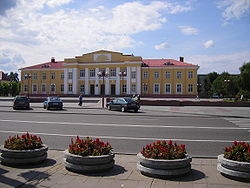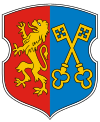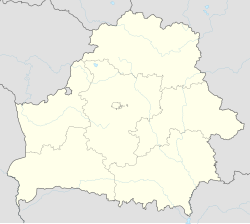Lida
|
Lida Ліда Лида |
|||
|---|---|---|---|
 |
|||
|
|||
| Location of Lida | |||
| Coordinates: 53°53′N 25°18′E / 53.883°N 25.300°E | |||
|
Country Subdivision |
Belarus Hrodna Voblast |
||
| Founded | 1323 | ||
| Government | |||
| • Mayor | Andrei P. Hudyk | ||
| Area | |||
| • Total | 50 km2 (20 sq mi) | ||
| Elevation | 158 m (518 ft) | ||
| Population (2015) | |||
| • Total | 99 976 | ||
| Time zone | FET (UTC+3) | ||
| Postal code | 231300 | ||
| Area code(s) | +375 154 | ||
| License plate | 4 | ||
| Website | Official website | ||
Lida (Belarusian: Лі́да; Russian: Ли́да; Polish: Lida; Lithuanian: Lyda; Yiddish: לידא) is a city in western Belarus in Hrodna Voblast, situated 160 kilometres (99 miles) west of Minsk.
The name Lida is derived from the name of the river Lidzeya. Its origin is associated with the Lithuanian appellative Lyda - Lydimas, meaning to fuse, to cast (denoting forest clearing). Names in other languages are spelled as Polish: Lida and Yiddish: לידע.
There are passing mentions of Lida in chronicles from 1180. Until the early 14th century the settlement at Lida was a wooden fortress in Lithuania proper. In 1323, the Grand Duke of Lithuania Gediminas built a brick fortress there. 1380 is generally considered the founding year of the city of Lida. The fortress withstood Crusader attacks from Prussia in 1392 and 1394 but it was burned to the ground in 1710. Following the death of Gediminas, when Lithuania was divided into principalities, Lida became the capital of one of them, the seat of Algirdas.
Lida was in the Grand Duchy of Lithuania. In the second half of the 14th century, after the Christianization of Lithuania the Catholic parish was established in former pagan lands and a Church was built by Jogaila (ruins are still preserved). Subsequently, in the 15th century the town became a centre of production by craftsmen and trade. Lida was connected with Vilnius, Navahrudak and Minsk. At that time the town had a market square and four streets: Wielenska, Zamkowa, Kamieńska and Krivaya. In 1588, Lida became the seat of Lida District in Vilnius Voivodeship. Magdeburg Rights were granted to the town in 1590 and confirmed in 1776 by the Polish Sejm. By these rights Lida held two annual fairs of little import to the local economy. The population was between 2,000 and 5,000 people. It was part of the Russian Empire after the third partition of the Polish–Lithuanian Commonwealth in 1795.
...
Wikipedia



